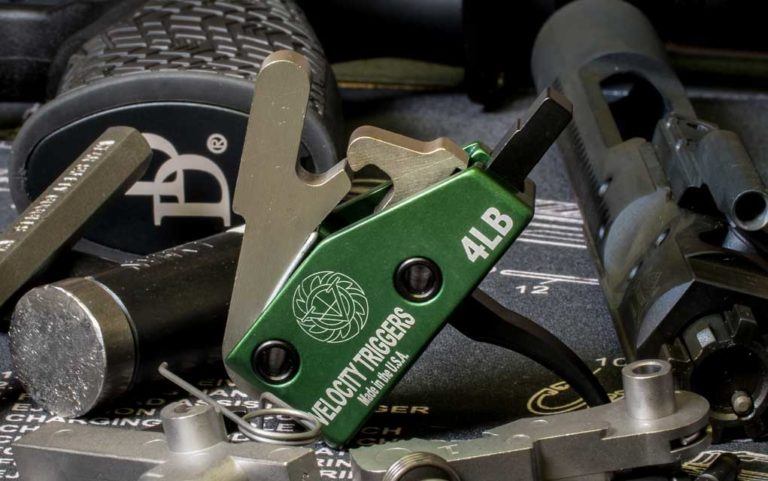
The quickest and easiest way to tighten your groups is to improve the trigger in your gun. Without a top-notch trigger, your shooting skills can only take you so far.
Aftermarket replacement triggers fast facts:
- Pull on a mil-spec trigger is anywhere between 5 and 9 pounds
- Up to a pound of pull weight fluctuation can be present from shot to shot on mil-spec triggers
- Mil-spec triggers travel dramatically — while safety is engaged
- A drop-in trigger can be installed in less than 10 minutes
- Velocity Trigger cost: $150
You don’t have to be the Head Line Leader of a TSA battalion to know that a poor-quality trigger will rob you of the true shooting potential both you and your rifle are capable of producing — especially in AR-style rifles. And although I might ruffle some feathers, I’ve ran enough A/B accuracy tests on a variety of rifle brands, models and platforms to say that upgrading the trigger is the first thing you should change on any and every AR you own, and it will enhance the performance of your rifle more than any other upgrade you can make.
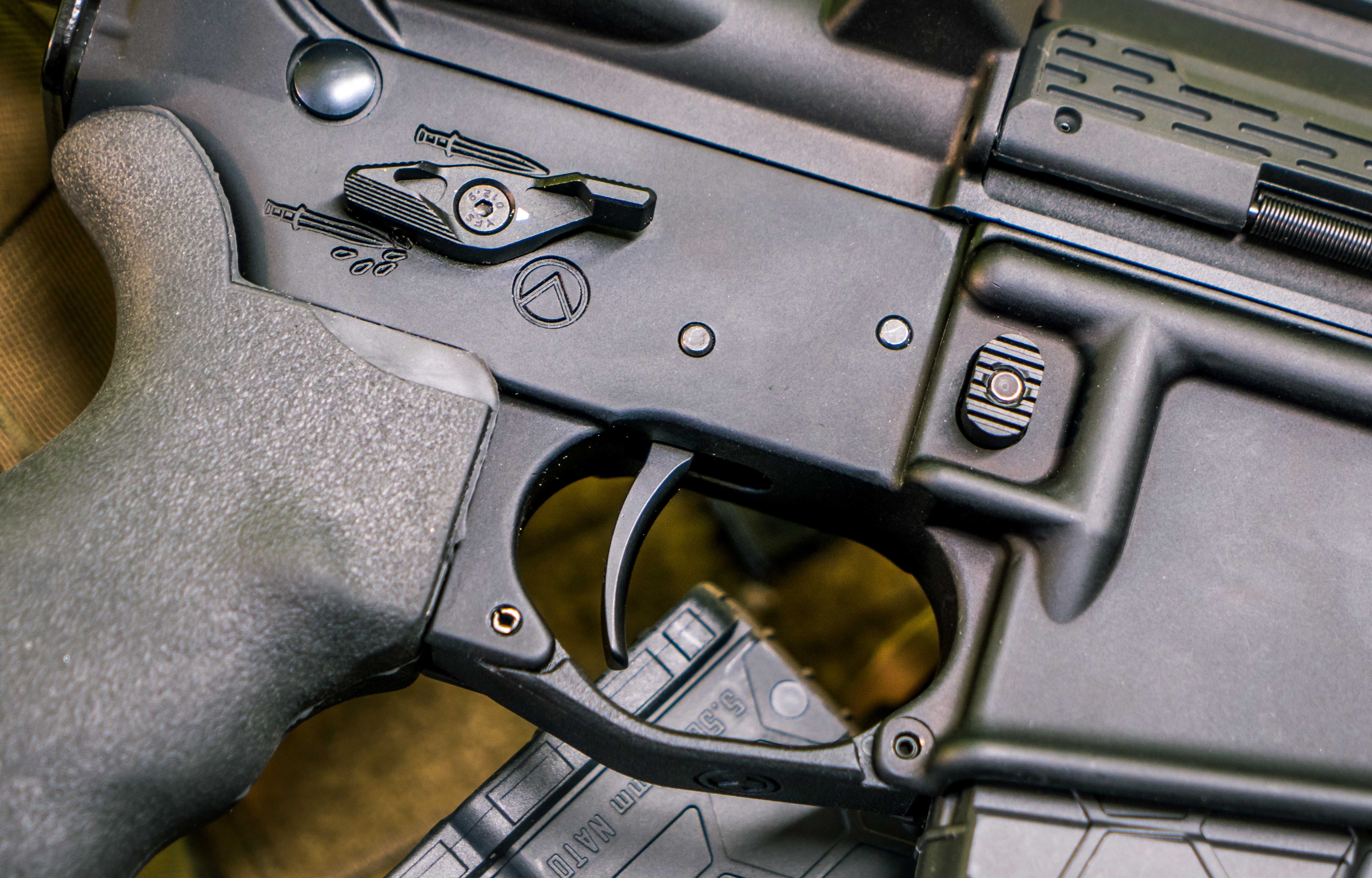
If we break down this concept of spending money to replace a functioning piece of a gun that already comes standard on every single rifle manufactured, it all comes down to performance and price. How much will it help me, and how much will it cost?
The simple answer: a lot more than you think for a lot less than you think.
Allow me to come at this from another way. The key to mastering any shooting discipline is unwavering consistency — consistency in the gun (including optics and ammo), consistency in the shooter and, most importantly, consistency in the interaction between the gun and the shooter.
As a shooter, you could win the Guinness World Record for being the World’s Most Aggressive Flincher, but as long as you flinch exactly the same way every single shot, you’d likely find yourself on par with some of the best shooters in the world, too. That’s the truth. In our world of shooting — again, regardless of discipline — consistency is king.
Mil-Spec Triggers
In all fairness, I must disclose that there are some AR-style rifle manufacturers out there who are doing a good job with their factory triggers, but you’ll find those guns in the upper tier of the price scale. It’s a very easy argument to make for buying a gun in the middle of the price pack, building that AR exactly how you want it, and still saving money that’s equally well spent on ammo or firearms training.
The overwhelming majority of AR manufacturers today are outfitting their rifles with mil-spec triggers. You know this. It’s not good or bad — it just is — and the mil-spec trigger does help keep the final price tag lower than it would otherwise be. But how much do you really know about mil-spec triggers?
- The mil-spec trigger is the lowest quality trigger that can purchased, but it’s also the cheapest. All components are cast with loose tolerances, and it’s rare that the finished surfaces are smooth.
- Spec pull is anywhere between 5 and 9 pounds.
- Up to a pound of pull weight fluctuation can be present from shot to shot, leaving you to always guess when the gun is going to fire.
- You’ll feel a large amount of gritty creep and an inconsistent pull weight.
- When the safety is engaged, the trigger can still travel a large amount.
- With a mil-spec trigger, the trigger travels farther on safe than an after-market drop-in trigger does to fully function.
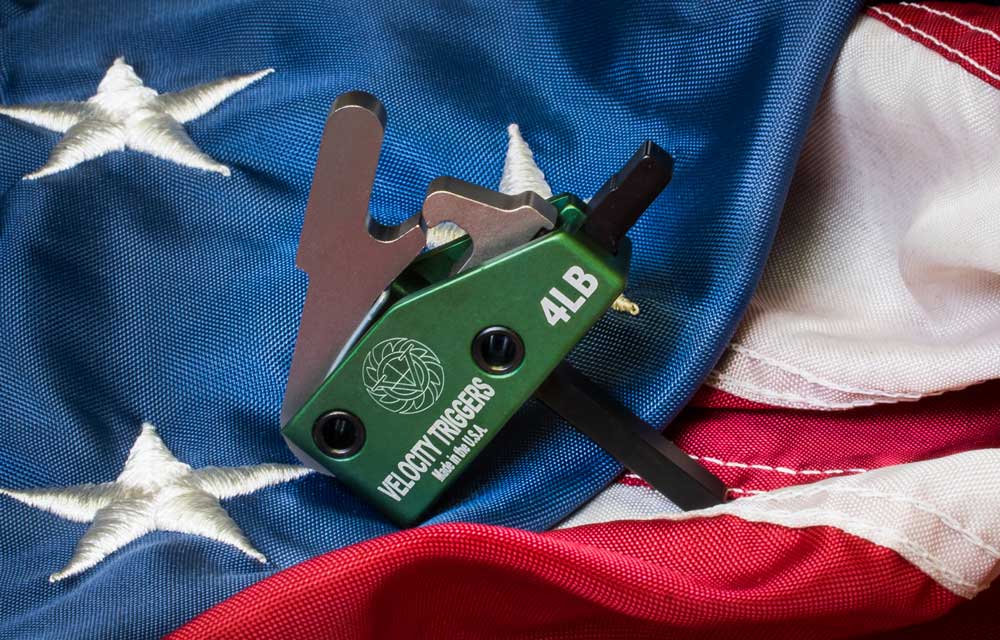
Have I made my point? A mil-spec trigger on a gun with a good barrel is exactly like buying a high-dollar precision rifle and putting iron sights on it. If you’re banging away at point-blank targets, then you might argue that none of this matters. Maybe. But I would argue that, in that instance, you’d be better served with a handgun anyway. For all other applications, you’ll be much better served with a replacement trigger.
So, as you’re reading this, you ought to be asking yourself, sweet, but assuming you have convinced me to upgrade my trigger, what’s this gonna cost me?
Look, I’ve got kids who keep taking food from my fridge, my bank still expects my mortgage payment every month and I have a chronic condition called trigger finger itchitis that can only be remedied with the smell of freshly fired ammunition. Aftermarket triggers are like ARs: There are some really good ones out there, but I won’t tell you to buy the top-of-the-line model because it’s not always necessary.
But here’s my short answer to your question above: $150.
I am intimately familiar with the triggers both Timney and Geissele are producing, and you’ll never catch me saying a bad word about either simply because they both make great products. However, when it was brought to my attention that Velocity Triggers is making an after-market, modular drop-in trigger of equal quality with a massively slashed price tag, I got curious.
The old adage you get what you pay for often holds true, but on the flip side of that coin, you can find yourself unnecessarily paying for a brand name — not necessarily a superior product — if you’re not careful.
The Trigger Family Business
Tom Vehr owns and operates Velocity Triggers out of Phoenix, Arizona, and when I learned that he builds topnotch triggers for substantially less than his competition, I figured we all deserved to know how — and why.
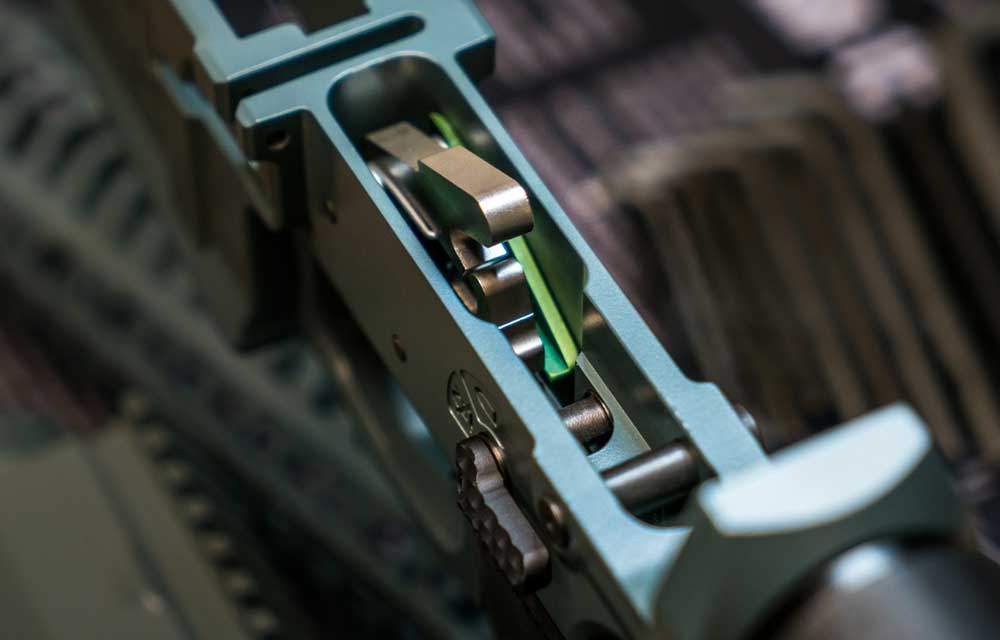
In 1981, Tom Vehr’s parents bought Timney Triggers, and for a full year after that purchase, Alan Timney — one of the pillars of aftermarket trigger innovations — mentored Tom on the nuances of building good triggers. And from his parents’ purchase until 1995, Tom ran Timney Triggers.
In 1995, Tom went to work for Knight Rifles, and for the next 13 years he built the tooling and oversaw the manufacturing of more than a half-million triggers for Knight during that company’s glory days when Knight was the standard all other muzzleloaders were measured against.
In 2008, Vehr left Knight Rifles and started his own custom machine shop before opening the doors to Velocity and building it from the ground up.
So why does all this matter? For starters, it’s interesting. I find the stories behind some of the oldest and most innovative brands in our industry to be fascinating. Want a good read? Do some research on the Mossberg or Beretta families.
But more importantly, this information on Tom’s background tells me two very important things in my mission to determine whether I can recommend a Velocity Trigger to you: The man at the helm of Velocity Triggers knows triggers better than most anyone else in gun world, and that gives immediate legitimacy to the Velocity brand.
So, I called Tom Vehr for some real answers:
LH: What inspired you to get into the aftermarket trigger business?
TV: I saw a need for a high-quality trigger, and just as importantly, it needed to be available at a reasonable price. There are no other aftermarket, drop-in triggers available well below $200. I knew I could manufacture a high-quality trigger at a fair price.
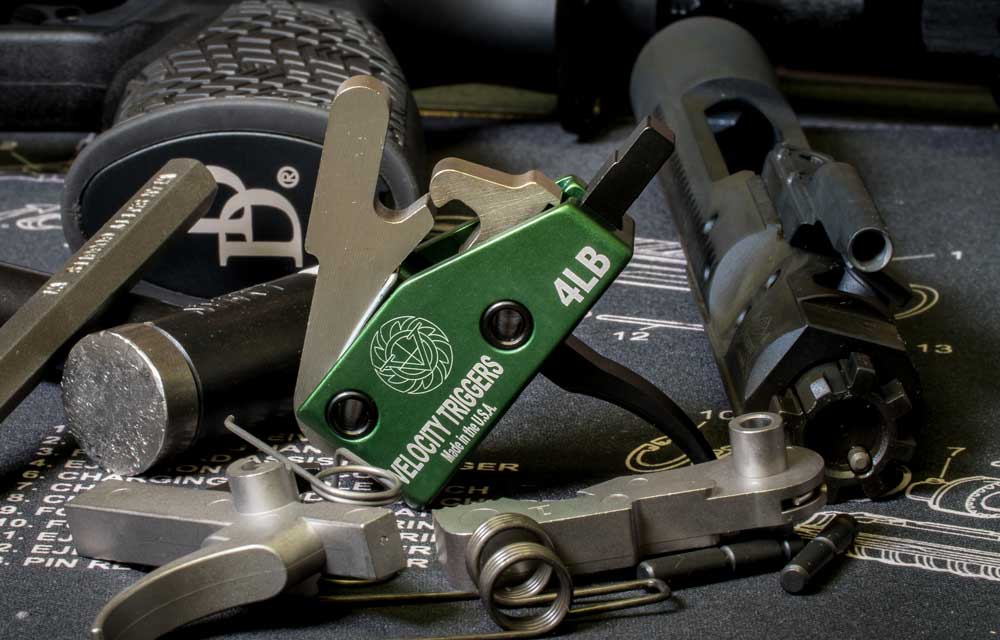
LH: So, Velocity has been around since 2013? Why have I not heard about you before earlier this year?
TV: It always takes time to build a brand. Velocity was started in 2013, and in 2015 I quit taking in outside machining work to focus on Velocity because of growth. In early 2017, we doubled the square footage of our manufacturing facility.
LH: How many triggers can you produce annually?
TV: I will tell you that we have two wire EDMs running 24/7 and we’re not keeping up. The wire EDM is the most precise way to manufacture internal components: — hammer, trigger and disconnect — and that precision matters. We also decided to bring all the manufacturing in-house so we could completely control consistency and maintain the quality of each and every part that goes into a Velocity Trigger. This also eliminates outside vendor costs. If it costs me less to make, then it costs the shooter less to buy.
LH: Generally speaking, when a shooter replaces a mil-spec AR trigger with a Velocity Trigger, what are the first things he or she is going to immediately notice within the first few shots?
TV:
- Exceptional consistency — consistency is everything
- There’s no creep and/or take-up
- The pull is exceptionally smooth
- Less than a couple ounces of pull deviation from shot to shot
- Accuracy will improve dramatically; groups will generally be cut in half
- Complete trigger change from AR to Velocity in 5-7 minutes.
LH: How many different triggers, or models of triggers, does Velocity offer?
TV: Velocity makes a few different triggers, but for ARs we offer both curved and straight models with either a 3-, 4- or 4.5-pound pull. The shape and pull weight is purely personal preference, but 80 percent of the Velocity Triggers that go out the door are curved, 3-pound AR triggers.
LH: After installing a Velocity trigger, what long-term maintenance is required?
TV: Blow it out with air annually with general use, or more often in very dusty conditions. There’s no lube required.
LH: You’ve recently introduced a new trigger. Give me some details on that.
TV: Yup, it’s the MPC: Marksman Performance Choice. The MPC sports a new design in which we moved the trigger forward a half-inch, which allows for quicker trigger engagement and a more ergonomic setup because the shooter’s finger isn’t forced to curl in so far.
Tom is clearly a modest man, and although he didn’t talk much about it, I’d argue that the coolest feature on the MPC is that the trigger shoe is 3/8-inch wide rather than the standard 1/4-inch. Because of an AR’s receiver design, the max width of a drop in trigger assembly is only 1/4-inch. By using a cap screw to simply attach the trigger shoe to the trigger itself after installation, a wide trigger can be achieved.
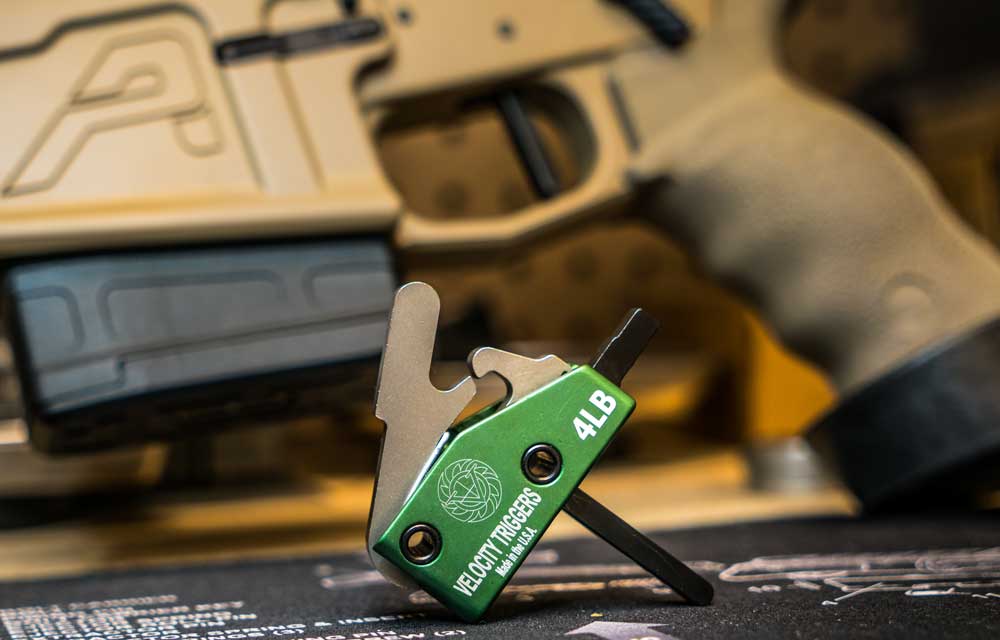
A quick peruse of the website also indicated that Velocity hangs it’s hat on “Diamond Like Carbon Coating,” so I dug deeper into what DLC is and what it does. In short, DLC is a surface treatment of the engaging area between the trigger and the hammer. Multiple passes with the EDM achieve a super-fine finish that creates a low fractional coefficient on the trigger. No hand-polishing is needed, it never needs lubrication, and it will never rust — and most importantly, it will never wear.
You heard me ranting earlier that consistency is king, and DLC seems to be the new industry standard upon which all others must now abide. In fact, I dug into DLC deep enough to find a testing report where a brand new AR was used. The gun’s barrel needed replacing just after 10,000 rounds. At about 40,000 rounds, the lower needed replacing … and the Velocity trigger showed negligible wear.
I like to lecture for as long as anyone will listen about how a drop-in trigger should be the first enhancement to every single AR they buy — and I haven’t yet heard a counter argument that holds up. But either way, whether you agree with me or not, you will never convince me that a $150 drop-in trigger, that can be installed by a first-timer in less than 10 minutes, is not worth every single penny.
I’d pay twice that amount of money for a trigger half as good — and I have — but I’ll never do it again.

Next Step: Get your FREE Printable Target Pack
Enhance your shooting precision with our 62 MOA Targets, perfect for rifles and handguns. Crafted in collaboration with Storm Tactical for accuracy and versatility.
Subscribe to the Gun Digest email newsletter and get your downloadable target pack sent straight to your inbox. Stay updated with the latest firearms info in the industry.

![Best Concealed Carry Guns In 2025 [Field Tested] Wilson Combat EDC X9S 1](https://gundigest.com/wp-content/uploads/Wilson-Combat-EDC-X9S-1-324x160.jpg)


![Best 9mm Carbine: Affordable PCCs [Tested] Ruger Carbine Shooting](https://gundigest.com/wp-content/uploads/Ruger-Carbine-Shooting-100x70.jpg)
![Best AR-15: Top Options Available Today [Field Tested] Harrington and Richardson PSA XM177E2 feature](https://gundigest.com/wp-content/uploads/Harrington-and-Richardson-PSA-XM177E2-feature-100x70.jpg)

I like that you mentioned how the quickest and easiest way to tighten your groups is to improve the trigger in your gun. I just got a pretty old gun and I think it would not be able to perform properly as-is. So, I am thinking of checking out some gun do it yourself upgrade resources to learn more.
https://shoot-on.com/gun-diy-upgrades